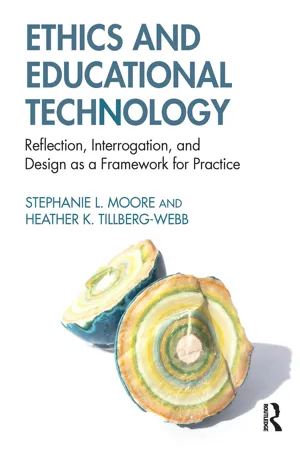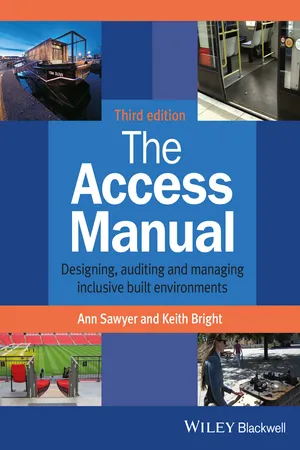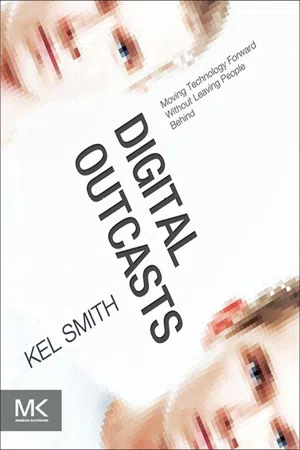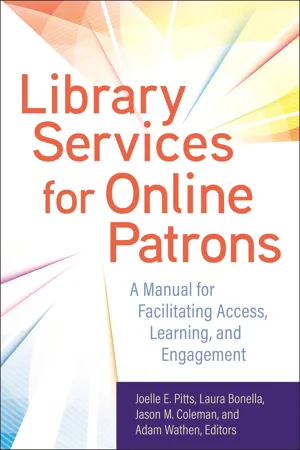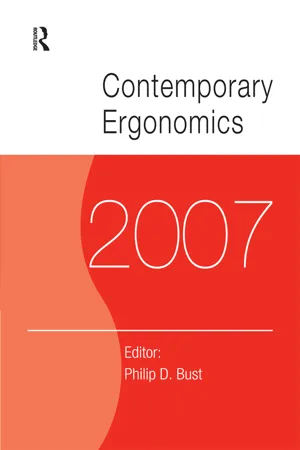Technology & Engineering
Inclusive Design
Inclusive design refers to the practice of creating products, services, and environments that are accessible and usable by as many people as possible, regardless of age, ability, or circumstance. It involves considering diverse user needs from the outset and designing with empathy to ensure that everyone can participate equally. This approach aims to promote diversity, equity, and inclusion in design and engineering.
Written by Perlego with AI-assistance
Related key terms
Related key terms
1 of 4
Related key terms
1 of 3
9 Key excerpts on "Inclusive Design"
- eBook - ePub
Ethics and Educational Technology
Reflection, Interrogation, and Design as a Framework for Practice
- Stephanie L. Moore, Heather K. Tillberg-Webb(Authors)
- 2023(Publication Date)
- Routledge(Publisher)
design exclusion revealed pragmatic places, such as capabilities and usability, where exclusion can be reduced – or stated differently, where inclusion can be increased. This approach makes an abstract construct like inclusion more amenable to design and decision making as well as evaluation of whether a given design feature or iteration makes a difference, making it possible to engage in an iterative process of continuous design improvement.Inclusive Design: A Synonym for All Human Diversity
By this point, a reader may be wondering where any discussion on other aspects of human differences and variability is. In the last five years or so, and especially in the last two years, Inclusive Design has itself taken on a more inclusive definition. For example, a separate center for design, the Inclusive Design Research Centre (https://achecker.ca/ ) at OCAD University, defines Inclusive Design as “design that considers the full range of human diversity with respect to ability, language, culture, gender, age and other forms of human difference” (Inclusive Design Research Centre, 2021 , para. 1). However, the history and influence of disability rights and inclusion is still a strong feature in their dimensions of Inclusive Design. They argue for a distinction between universal design and Inclusive Design expressly because designing for digital environments affords different options than designing physical environments. When designing a physical environment, the architect usually has just one building to work with. That one building must work for everyone. In the digital space, space becomes a more varied and fluid construct and thus the design becomes a more varied and fluid process. Specifically, they note that digital environments do not necessarily require a “design for all” or “one-size-fits-all” because digital contexts afford more flexibility to take a “one-size-fits-one” approach to inclusion (para. 10). They also note that universal design has come to be more synonymous with users with disabilities, and many resulting guidelines tend to operate within constrained categories that afford little variability within those categories (e.g., assuming all blind users use Braille). Finally, they argue that while universal design focuses on “creating a common design that works for everyone, we have the freedom (in digital environments) to create a design system that can adapt, morph, or stretch to address each design need presented by each individual” (Inclusive Design Research Centre, 2021 - eBook - ePub
E-Health Two-Sided Markets
Implementation and Business Models
- Vivian Vimarlund(Author)
- 2016(Publication Date)
- Academic Press(Publisher)
Each of us is unique in and of ourselves, and changing from moment to moment. The context around us is also ever-changing, adding additional complexity to understanding our behavior, preferences, and needs. While many of our technologies attempt to “know” what we want and need or how we feel, ultimately only we ourselves can fully know and potentially express these things. Technology that tries to anticipate what we need, think, and feel can only offer a best guess based on sophisticated but limited algorithms that attempt to reduce our complex selves to probability and pattern and may well rob us of potential self-knowledge.Inclusive Design is design that aims to recognize the uniqueness and diversity in all of us, and wherever possible let each individual make decisions for themself. By extending agency to individuals, Inclusive Design puts an end to cycles of exclusion and technology that strip us of choices. The burden is shifted from an individual to behave predictably and typically to an interface to be designed with diversity, complexity, and the unexpected in mind. The practical implications of this for designing systems and interfaces are that users must be able to make choices and declare preferences wherever possible. One way to make that possible is to prioritize personalization. A one-size-fits-one approach empowers users to declare what works uniquely for them in their changing context—in other words, let the user decide wherever possible. This can translate into practicable steps in the design process where designers can acknowledge human diversity by offering flexibility and customizability or personalization whenever possible.What is personalization though? It is intended to be different for everyone, so designs must be flexible and make as few assumptions as possible. Design decisions risk being exclusionary if they aren’t made with diversity in mind. If I as a designer of an interface put a blue button in the upper left of my page to serve a particular function, I’ve made potentially exclusionary decisions with each declaration: blue and not any other color, upper left and nowhere else, button and no other affordance, and only this function. Those four decisions: - eBook - ePub
- Julie Fleck(Author)
- 2019(Publication Date)
- RIBA Publishing(Publisher)
Reading University responded to BEPE by setting up its Breaking down Barriers project in 2015, a cross-disciplinary project that is integrating Inclusive Design into the teaching and learning of a wide range of students, including students from the School of the Built Environment, the Henley Business School, the School of Art and Communication Design and the Department of Real Estate and Planning. The aim is to enhance the student experience and employability by:- developing a cross-disciplinary expert knowledge base
- prioritising experiential learning with a strong user focus
- engaging with real-world scenarios and external organisations.26
Students discuss and debate the principles of Inclusive Design, how designers can achieve inclusion in real-life projects, how design briefs often tend to create segregation and how designers can develop more inclusive solutions to briefs.Encouraging clients to embrace an Inclusive Design approach
Inclusive Design is about maximising the market potential of your products by making sure the maximum number of people can use them.’Simeon Keates and John Clarkson, University of Cambridge 27Missing out on £249 billion
We are gradually starting to change our perceptions of disabled people, recognising that disabled people are consumers and customers, employees, business owners, company directors, entrepreneurs and political leaders. They are us. This shift in perceptions has been helped by the gradual increase (although still limited) of disabled people in the media. Presenters such as Ade Adepitan, Adam Hills and Alex Brooker now present mainstream not specialist ‘disability’ TV programmes. However, change is slow, and businesses continue to miss out on this largely untapped market.Government statistics make the business case for inclusion absolutely clear. There are 13.3 million disabled people in the UK (one in five of us), with a total spending power of £249 billion (known as the ‘purple pound’).28 - eBook - ePub
The Access Manual
Designing, Auditing and Managing Inclusive Built Environments
- Ann Sawyer, Keith Bright(Authors)
- 2014(Publication Date)
- Wiley-Blackwell(Publisher)
1 Inclusive Design- An inclusive approach
- Principles of Inclusive Design
- Benefits
- How environments are used
- Access appraisals
- Access statements
- Case study – Canada Water Library
An Inclusive Approach
An inclusively designed and managed building or space will allow everyone to maximise their own individual abilities and enjoy full, equal, confident, independent and safe participation in everyday activities. Inclusive Design goes beyond simple accessibility. A design that offers a choice of stepped or ramped approach to a building addresses accessibility for all; however, one that incorporates a level approach for everyone to use is a truly Inclusive Design.Design guidance is often based on the needs of a notional ‘average’ person; however, everyone varies from the average in some way. People differ in height, strength and dexterity; can have different visual, hearing or cognitive abilities; or may have respiratory impairments or reduced stamina. Mental health or emotional issues can also affect people's ability to interact with the built environment. Physical and mental health conditions can be temporary, ongoing or progressive and may vary considerably throughout different stages of life. Older people may have limited mobility; some may use wheelchairs, sticks or crutches. Mobility may be affected by having to carry a child or heavy shopping bags or push a buggy.Despite this apparently wide diversity of need, many of the issues that affect how people interact with the built environment are similar. For example, good, clear, effective and sensibly used signage incorporating symbols helps everyone, including those whose first language is not that of the information on the sign. Firm, level, non-reflective surfaces will not only benefit people using mobility aids such as a wheelchair or crutches, but also people pushing buggies or carrying luggage. Well-designed lighting, colour and visual contrast may benefit people with sensory or cognitive impairments and will also affect how people feel and are able to respond to spaces and places. - eBook - ePub
Digital Outcasts
Moving Technology Forward without Leaving People Behind
- Kel Smith(Author)
- 2013(Publication Date)
- Morgan Kaufmann(Publisher)
Many project teams acknowledge the importance of designing for all users, yet are uncertain where or how to begin. Ms. Wassmer advocates a mindset of adjustment that harnesses advocacy throughout the design process, resulting in products that fulfill a social responsibility to their users. Introducing the concepts of Inclusive Design can be accomplished if the following best practices are applied as a team philosophy: Accessibility is not an “add on,” it is a critical part of an Inclusive Design strategy. Integrate accessible design from the start. If you knew that you had to build a house to accommodate someone in a wheelchair, you wouldn’t wait until the final phase to install a ramp. Thinking with accessible design in mind from the start allows easier updating and increased flexibility. It also ensures a smoother workflow between design and development teams, as an established baseline is always better than springing on a late-game requirement at the last minute. Chose the right toolkit. Current wheelchairs are made of titanium, which is half the weight and much easier to push than models used just 15 years ago. Using the correct authoring tools with accessibility guidelines can also ease the delivery of electronic media. Just about every browser has some built-in development tool for spot-checking accessibility. The web accessibility evaluation tool called WAVE, created and distributed by WebAIM, is perhaps the best utility for testing accessibility on the fly. Focus on message and keep the presentation flexible. Remember that there is no typical audience and no typical end user. An inclusive product experience is approachable, uncluttered, and treats users respectfully. Communication messages almost always begin with a focus on aesthetic presentation, but starting with a strategic goal with multiple audiences in mind keeps project specifications on point - eBook - ePub
Library Services for Online Patrons
A Manual for Facilitating Access, Learning, and Engagement
- Joelle E. Pitts, Laura Bonella, Jason M. Coleman, Adam Wathen(Authors)
- 2019(Publication Date)
- Libraries Unlimited(Publisher)
Chapter Three Inclusive DesignJoelle E. PittsIntroduction
Online patrons approach libraries from a variety of circumstances. Their location, connection speed, physical and cognitive ability, language proficiency, digital literacy level, socioeconomic status, and many more factors have the potential to affect your ability to provide quality services and resources to this population. Sometimes you will be aware of the circumstances because the patron will disclose that information or there will be some other indicator. More often, you will not know the exact combination of circumstances a particular patron is facing when they make contact with a service point or begin to interact with your online interfaces. When you start taking action on the goals you create (see Chapter 2 ), it is important to employ a design process that will allow you to serve the most online patrons possible no matter their circumstances.Inclusivity and equitable services and resources are important aspects of librarianship. It is easier to plan for and create services for people you see and communicate with personally, especially on a regular basis. However, online use of library resources and services is growing, and our professional standards, for example, the Association of College and Research Libraries’ Distance Learning Section Standards for Distance Learning Library Services , state that it is our duty to provide equitable service. You should not only be aware of your growing online population but should also make a concerted effort to listen to and amplify their voices.We recommend employing a way of thinking about inclusive environments called universal design (UD). Universal design was born out of the disability rights movements of the mid-20th century and focused primarily on the design of built or physical environments that were inclusive of people with a wide variety of abilities. In recent years, the UD concept has been adopted and adapted into other fields and disciplines, most notably for this volume, in libraries using the Universal Design for Learning (UDL) model. The concept of environment - eBook - ePub
- Paul T. McCabe(Author)
- 2018(Publication Date)
- CRC Press(Publisher)
More recent technological developments are beneficial to deaf and hard of hearing people. The Internet and mobile phones facilitate text communication. Both technologies have been widely taken up by both hearing and deaf people, providing equal access to text communication for everyone. Unlike textphones, which are a specialist technology, the Internet and mobile phones with SMS facility are widely owned and used by all groups of society. This integration has the potential to make communication far easier for deaf and hard of hearing people, assuming correct considerations are made during service development.Inclusive Design
An Inclusive Design approach can make many products more accessible to deaf and hard of hearing people. It is rarely (possibly never) the case that the needs of every user can be incorporated into every product, and as such there will always be a market for specialist products. However, economies of scale mean that mainstream products that meet the needs of deaf and hard of hearing people are always preferable over specialist design solutions. Such specialist products are not only expensive when compared to more mainstream products, but often fall behind while technology and product development in other areas forges ahead. When a specialist product is chosen as the way forward it should only be as a last resort.In addition to the benefits that will be incurred by deaf, hard of hearing, and other disabled people, an Inclusive Design approach can have a number of advantages for manufacturers. Many people, particularly older adults, have a disability of some sort, and hearing loss is very common. To release a product to the market that is not accessible and usable by such a large group of people may result in lost revenue and a reduction in market share. In addition, features that make a product accessible to people with disabilities will often also make the product more attractive to users in general.When involved in designing products or services that should be accessible to deaf and hard of hearing people, there are a number of factors to be taken into account. The information given in this paper provides an insight into the types of deafness that there are, and some of the ways that hearing loss can impact on a persons life. Rather than making assumptions based on this or other information, it is vital to involve members of different groups of potential users early in the design process, so that their requirements are considered and included wherever possible. - eBook - ePub
Contemporary Ergonomics 2005
Proceedings of the International Conference on Contemporary Ergonomics (CE2005), 5-7 April 2005, Hatfield, UK
- Philip D. Bust(Author)
- 2023(Publication Date)
- Taylor & Francis(Publisher)
Inclusive Performance Specifications could therefore be developed and used to define the performance qualities that would enable all users to carry out the functions and activities they require easily, safely, effectively and comfortably. These specifications could provide the systems goal for an inclusive home, an inclusive housing development system as suggested above under “A Systems approach to Inclusion” or for an inclusive refurbishment system such as the “Smart, Inclusive Homes” initiative outlined by Chesters (2005). They could also be used to define the required performance qualities for domestic utilities, products or systems that could be fully used by all their potential users. Part 4: Using evidence-based choice and innovation to achieve inclusion The final stage of the model is concerned with achieving inclusion by both “designing-out” and “choosing-out” any barriers that have been reported by users. The processes of systematic, evidence based choice and innovation, as described by Mitchell et al (1998), rely on routine user feedback as the primary means of alerting users, providers and commerce to the availability, benefits and opportunities of inclusive products and systems in comparison with their non-inclusive counterparts as shown in Table 1. References Bennington et al. 2000, Autonomy for Disabled People, (King’s Fund) Chesters et al. 2005, Evidence for Choice and Innovation, (Contemporary Ergonomics) (in press) Commission on Architecture in the Built Environment, 2004. Mitchell et al. 2004, “Designing out the Cell of Exclusion”, (Contemporary Ergonomics), pp 445–449, ISBN 0 8493 2342 8 Mitchell et al. 2004, “Why can’t we have a home with nothing wrong in it?” (ILS) Mitchell et al - eBook - ePub
Contemporary Ergonomics 2007
Proceedings of the International Conference on Contemporary Ergonomics (CE2007), 17-19 April 2007, Nottingham, UK
- Philip D. Bust(Author)
- 2018(Publication Date)
- Taylor & Francis(Publisher)
A spectrum of users completed trials on two consumer products. The trials were split into tasks that varied from ‘everyday’ usage to those seldom used. Correct completion of a task was represented by a series of operations that was analysed to identify its demands on experience. Previous experience was scored by a questionnaire where positive answers were weighted based on how relevant the experience would be in using the new product.Studying the relationship of error occurrences and task times against experience scores with the individual task demands reveals the detailed effect of individual product features in assisting the user to learn a new product. This understanding of key product features can be used to provide guidance to designers who wish to include older populations.Introduction
Inclusive Design pursues a goal to design mainstream products that are useable to as many people as possible without the need for special adaptation or specialised design (e.g. BS7000 Part 6). To encourage designers to adopt Inclusive Design, tools and guidance have been produced. Sensory and physical disabilities can, to a partial extent, be simulated by adapted, glasses, ear plugs and muscle restrictors. These provide the designers with an experience revealing the typical problems the intended user might incur. This personal understanding of the restrictions an impairment might provide help the designer to create more inclusive consumer products. However, for cognitive impairments the available simulations are significantly less accurate, often providing the designers with distractions to overload their cognitive ability. Whilst they can be adapted to produce similar time and error performances, the simulations fail the objective of providing the designer with empathy of the user’s impairment. Guidance forms the substantive part of how designers gain an understanding of the user’s cognitive abilities. Designers who adopt Inclusive Design usually produce a product that is more useable by the whole population.Understanding the users’ past experience of consumer products is one area that can help improve the cognitive guidance available. A key learning period in users’ lifetimes has been identified (e.g. Docampo, 2001) of between 0 and 25 years old. New products learnt in this time remain influential in later years and it is possible to consider these influential products for any existing generation (e.g. Lim and MacDonald, 2005). Key generations where this learning period is bordered by a significant change in the technologies used can also be identified, e.g. Docampo, 2001. The technological change may refer to the method of interaction demanded of the user, the symbols and terminology used, the level of modality or some combination of all of these and more.
Index pages curate the most relevant extracts from our library of academic textbooks. They’ve been created using an in-house natural language model (NLM), each adding context and meaning to key research topics.
Explore more topic indexes
Explore more topic indexes
1 of 6
Explore more topic indexes
1 of 4
